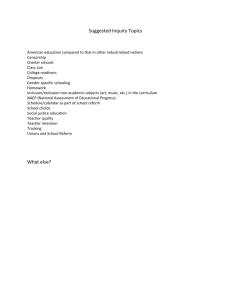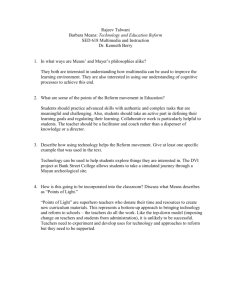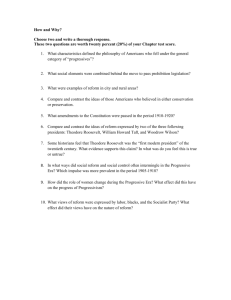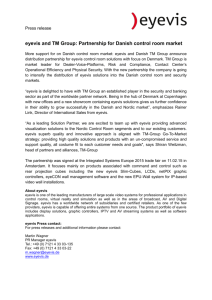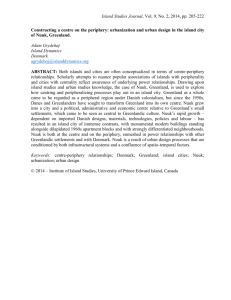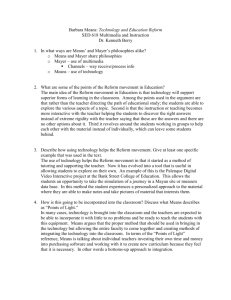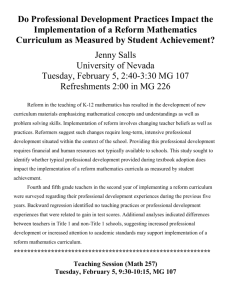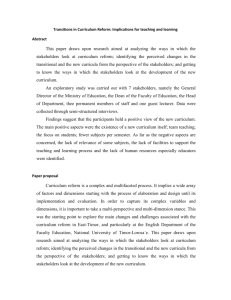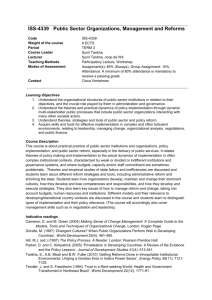The Role of Culture in Culturally Compatible
advertisement
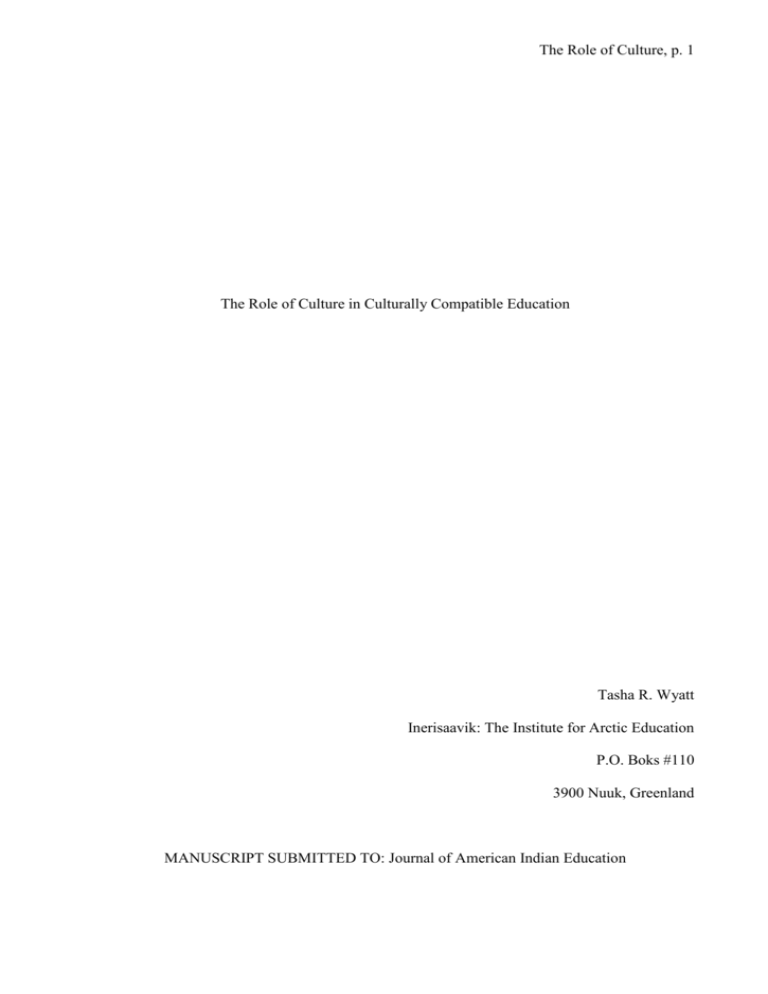
The Role of Culture, p. 1 The Role of Culture in Culturally Compatible Education Tasha R. Wyatt Inerisaavik: The Institute for Arctic Education P.O. Boks #110 3900 Nuuk, Greenland MANUSCRIPT SUBMITTED TO: Journal of American Indian Education The Role of Culture, p. 2 Abstract In spite of colossal efforts to transform educational spaces for culturally and linguistically diverse learners, undesirable ideology still manages to appear in transformed classrooms. This article demonstrates how despite a commitment to culturally compatible education, reform leaders in Greenland interpreted a model of effective pedagogy developed by the Center for Education, Diversity, and Excellence (CREDE) in ways that promoted a continued colonial perspective in the Greenlandic schools. By analyzing reform leaders’ interpretation of two CREDE Standards, this article shows that in spite of the research on how to use appropriate pedagogy in the education of culturally and linguistically diverse populations, Danish reform leaders interpreted contextualization and modeling in a way that undermined the cultural and political goals of Greenland’s reform. The Role of Culture, p. 3 The Role of Culture in Culturally Compatible Education Introduction to Greenland In the 1970’s and earlier, Greenland’s school system was largely a copy of European models developed in Denmark and Scandinavia and reflected little of the Greenlandic culture (Olsen, 2005). Several reforms were initiated in the 1970s and early 1990s that made slight adjustments to the educational system already in place, but had little impact on classroom instruction (Olsen, 2005). Atuarfitsialak, Greenland’s latest educational reform, is by far Greenland’s most comprehensive efforts at change. Its purpose is to shift from the European model of schooling and build a system using the “cultural competence and educational needs of Greenlandic students” (Olsen, 2005, p. 1). Strengthening Greenlandic identity has been a priority for Greenlanders since the abolishment of Greenland’s colonial status in 1953, but even more so with the establishment of Home Rule in 1979. Advocates for Home Rule saw education as a means to strengthen Greenlandic cultural and national identity (Goldbach & Winther-Jensen, 1988). One participant explained that it was a political value of the 1970s through the 1990s that the design of activities in Greenland had to be Greenlandic: “As a nation we had to improve our identity by working with our language and culture” (Interview with Kaali Olsen, March 3, 2006). This “Greenlandization” was carried forward into the development of Atuarfitsialak so that the new school system was designed to fit “the culture, language, and history of Greenland” (Interview with Paartoq Olsen, June 13, 2006). The result was the adoption of Principles for Effective Teaching and Learning developed by the Center for Research on Education Diversity and Excellence (CREDE) as a means to assist in the development of culturally compatible education. The Role of Culture, p. 4 Culturally Compatible Education. The culturally compatible hypothesis (Jordan & Tharp, 1979) assumes that culturally-based differences between the home and school may lead to “conflicts, misunderstandings, and ultimately failure for those students” (Ledlow, 1992, p. 23). This hypothesis suggests that for some groups of students, transition to school is difficult because these differences are too overwhelming to overcome. Further, if these differences were minimized, then all students would have an equal opportunity to achieve success (Baker, 1997; Tharp, Dalton, & Yamauchi, 1994b). The null form of this hypothesis is the existence of a universal approach to instruction that is effective in any setting. In designing culturally compatible education, initiators are faced with how to define culture and how it will be understood and used in education. Often, indigenous groups shift the language of instruction to be more culturally compatible (Todal, 2003; Yamauchi, Ceppi, & Lau-Smith, 2000). For example, Ke Kula Kaiapuni, a K-12 public school program in Hawaii was established as an attempt to revive the Hawaiian language after colonialism nearly wiped out its use (Yamauchi, Ceppi, & Lau-Smith, 2000). Kaiapuni students are instructed in Hawaiian and participate in a curriculum infused with Hawaiian values. Similarly, in New Zealand, Maori parents felt the public school system was not compatible with Maori culture and belief systems (Smith, 2000). Their efforts resulted in range of alternative schooling innovations that have focused on Maori language and cultural revitalization. The most promising initiatives have approached culturally compatible education at the level of pedagogy by paying particular attention to the role assistance plays in cultural expression (Tharp, 2006). The Kamehameha Early Education Program (KEEP) in Hawaii has produced some of the most compelling evidence for how culture can be used in education of diverse learners (Ledlow, 1992). Researchers interested in identifying Hawaiian students’ low academic achievement and high dropout rate, employed anthropologists to study Hawaiian The Role of Culture, p. 5 students’ social organization and sociolinguistic patterns. Their observations resulted in a program specifically designed for Hawaiian students’ social and linguistic needs (Tharp & Dalton, 2007). Standardized tests indicated that students’ literacy and reading skills were improved as a result of participating in this program (Au & Jordan, 1981). To test whether the KEEP program was universally applicable or culturally specific, researchers transferred the identical pattern of classroom organization into Navajo classrooms. Tharp and Dalton (2007) wrote “In surface appearance, the Hawaiian and Navajo classrooms’ common pedagogical system made for instant recognition as sister programmes” (p. 56). Yet, there were more subtle differences in teaching that rendered the program ineffective for Navajo students. Tharp (2008) argues that the differences between the two are a direct result of cultural patterning in interaction between teacher-student and student-student expressed in the classroom. Tharp (1989) wrote that in the natal Hawaiian culture, collaboration, cooperation and assisted performance are commonplace, but in the Navajo classroom, students are not accustomed to these types of interaction patterns. Navajo students didn’t solicit feedback or assistance from others as was often seen with Hawaiian students. Other sociolinguistic differences included Navajo children requiring longer speech turns and wait times between turns, whereas Hawaiian children overlapped their speech and participated in co-narration (Tharp & Dalton, 2007). Additionally, peer interaction required smaller groups and same-sex grouping in Navajo society. Jordan (1992) concluded that the necessity to modify the Hawaiian-culturally compatible KEEP program to a Native American, Navajo-culturally compatible supported the idea that classrooms need to be considered for their specific cultural differences. These cultural differences are played out most explicitly in student-teacher interaction and means of assistance. The Role of Culture, p. 6 While all teachers of Hawaiian and Navajo students used a variety of means of assistance, Tharp (2008) wrote that there were cultural “preferences and frequencies in the patterns of usage [that] were sharply different in effectiveness across cultures” (p. 815). Hawaiian children responded well to questioning, instruction, and contingency management (reinforcement to shape behavior), where as Navajo children were most responsive to cognitive structuring and modeling-demonstration. Culture was expressed in these educational programs through patterns of interaction and social organization that were familiar to the individual cultural groups. Key findings in the KEEP work include four variable cultural features recognized as important in tailoring educational settings for cultural compatibility (Tharp & Dalton, 2007): Motivation (individual or collective); cognition (holistic or analytic); sociolinguistics (courtesies and conventions of conversation); and social organization (age, gender, and adult-child relationships). According to Tharp (1989), these psycho-cultural variables need to be examined and adjusted in the tailoring of classrooms to children of different cultures. Further, an emphasis on language development and contextualized instruction should be included, regardless of cultural settings. CREDE’s Principles for Effective Teaching and Learning Greenland’s reform leaders adopted CREDE’s Principles for Effective Teaching and Learning to assist in creating culturally compatible education. Many of the same researchers and educators who worked in Hawaii’s KEEP program were also employed at CREDE and involved in the research and development of the Standards. These Standards are principles of teaching and learning designed to assist educators in the promotion of higher level learning (Tharp, Estrada, Dalton, & Yamauchi, 2000). They were developed through a synthesis of 30 years of research on effective instruction for culturally and linguistically diverse students (Tharp, Estrada, Dalton, & Yamauchi, 2000). The Role of Culture, p. 7 The Standards derive from Vygotsky’s (1978) sociocultural theory which suggests that all higher psychological processes have their roots in social interaction. This theory suggests that when children interact with people more experienced, they eventually appropriate symbols, such as language, that are used in the interaction. Learning occurs when community members assist novices in performing tasks and roles needed to be a part of the larger culture. By engaging in activity that is familiar, children internalize this cultural knowledge and develop sophisticated thought processes that further assist in cognitive development. Over time, children need less assistance until eventually the learners are able to perform the activity on their own. The first Five Standards are (a) Joint Productive Activity, teachers and students collaborating on joint products; (b) Language and Literacy Development, teachers supporting language development in all classrooms and subjects; (c) Contextualization, teachers making connections between students’ prior knowledge and new information; (d) Complex Thinking, teachers supporting students’ engagement and skills in complex thinking; and (e) Instructional Conversation, teachers instructing though dialogue (Tharp, Estrada, Dalton, & Yamauchi, 2000). The sixth Standard, (f) Modeling, makes use of indigenous student’s preference for learning by observation (Cazden & John, 1971). It is based on traditional ways of learning that include modeling and observation (Hilberg, Tharp, & DeGeest, 2000). The seventh Standard, (g) Self-Directed Activities, promotes student involvement in decision-making. Standards six and seven were initially conceptualized only for teacher use when working with indigenous groups (Hilberg, Tharp, & DeGeest, 2000). Several studies have found higher enactment of the Standards is related to greater student achievement (Tharp, Estrada, Dalton, & Yamauchi, 2000). For example, in a study of bilingual elementary classrooms, Estrada (2004) found that student achievement in English and Spanish was strongest among students whose teachers implemented the first Five Standards to a higher The Role of Culture, p. 8 degree. Dohery, Hilberg, Pinal, and Tharp (2003) found that compared to another school matched on student characteristics, achievement was higher at an elementary school implementing the Five Standards. Within the latter school, achievement was highest for students whose teachers were more successful in enacting the CREDE Standards rated by the Standards Performance Continuum (Doherty, Hilberg, Pinal, & Tharp, 2003). Several studies conducted by Saunders and Goldenberg (1999a; b) have found the Instructional Conversation to be useful in assisting students’ thematic understanding of literature. When the Instructional Conversation was coupled with Contextualization there was an even greater effect for English Language Learners (ELL). Other studies have shown that Joint Productive Activity (JPA) is positively related to Latino ELL students’ meta-cognitive development and use of effective reading strategies (Doherty & Pinal, 2002). Greenland & The CREDE Standards. Prior to the adoption of CREDE’s model of effective pedagogy, Greenland’s reform leaders spent several years studying the Standards and discussing their applicability in the Greenlandic context. Many of the participants in this study visited the CREDE institute in Santa Cruz, California where they attended researcher-facilitated workshops and courses. They also read related books and articles and observed laboratory classrooms that employed the Standards. Finally, in 2004, reform leaders adopted the CREDE model as a means of fulfilling the New School Act of 2002. However, soon after Greenland’s adoption of pedagogical model, conflict erupted between Danish and Greenlandic reform leaders. Reform leaders opposed each other’s interpretation of the Contextualization and Modeling Standard that eventually resulted in Danish reform leader’s resistance to implementation. Using grounded theory, this study aimed to understand why these two Standards were viewed as problematic for Danish reform leaders and yet highly coveted by the Greenalnders. The Role of Culture, p. 9 Method Participants Participants included 11 key informants (Fontana & Frey, 1997; Yin, 2003) who were selected based on their employment tenure at Inerisaavik, the institute responsible for implementation of Atuarfitsialak. All 11 participants were involved in the reform in its initial stages or shortly thereafter, apart from one participant who had been working for Inerisaavik for only a few months at the time of his interview. Four of the 11 participants worked as consultants for Inerisaavik, advising teachers on curricular issues. Three were a part of Inerisaavik’s leadership group, responsible for making decisions for the organization and delegating tasks to subordinates. An additional two were politicians from the Ministry of Education and were responsible for writing new legislation for Greenland’s schools. These nine participants were part of a highly educated and politically sophisticated group of Greenlanders who have been working for many years toward the goals of Greenland’s independence from Denmark (R. Tharp, personal communication, May 8, 2007). In fact, a number of these participants were involved in the 1960s movement that resulted in the establishment of Greenland’s Home Rule government. The final two participants were external consultants to Inerisaavik and had been involved in Greenland’s reform for several decades. Data Collection & Analysis Data was collected through participant observations and informal interviews (Fontana & Frey, 1997). Participant observations were conducted on an on-going basis beginning in August, 2005 and were used to capture various realities within the reform. Observations allowed for various complexities to emerge and informed further research questions (Alexander, 1982). Semi-structured interviews made use of probing and open-ended questioning techniques in order to elicit richness in responses (Bogdan & Biklen, 2003). The Role of Culture, p. 10 Constant-comparative methods were used to analyze the data. According to Cohen, Manion, and Morrison (2000), constant comparison method of analysis has its roots in grounded theory methodology in which the process of data collection and data analysis is interactive, iterative, and can be revised with new information. Using this technique, data are collected by comparing social phenomena across categories allowing new categories and dimensions to emerge. Because this study has its roots in grounded theory, these emergent themes shaped further lines of inquiry. It is recommended for qualitative work that at least 4-12 months of prolonged engagement is spent in the field (Creswell & Miller, 2000). For this study, 18 months were spent living and working in Greenland. Validity was also used by employing two colleagues who were used for peer debriefing (Creswell & Miller, 2000). These peers challenged assumptions, asked difficult questions, and assisted in clarifying themes in the study. One peer was an outsider to the Greenlandic community and was used as a sounding board for broader issues of equity, access to education, and political development. The second peer was employed in the research department at Inerisaavik and had previously analyzed issues related to mental colonization in Greenland. Results In 2000, reform leaders in Greenland adopted the CREDE Standards for Effective Teaching and Learning as a means of implementing Atuarfitsialak. At first, reform leaders were pleased with how the Standards dovetailed with the new School Act. One participant explained that “every standard fits in the paragraphs [of the new School Act]. I have found a paragraph [for] each Standard, so it is, in fact . . . the new School Act” (Interview with Bent Mortenson, September 1, 2005). The Role of Culture, p. 11 In time, contextualization and modeling were deemed problematic in teaching in the Greenlandic context. Although both groups viewed contextualization and modeling as effective teaching tools, Danish and Greenlandic reform leaders disagreed on how to interpret their use. Greenlandic reform leaders hoped the Standards would highlight Greenlandic cultural strengths, thereby instilling a strong sense of pride and self-efficacy. Danish reform leaders were a bit sceptical in using aspects of Greenlandic culture to teach. They interpreted the Standards in ways that undermined the local Greenlandic culture, submerging it with a Danish ideology and colonial power relations. Contextualization Initially, the CREDE Standard, contextualization, was thought to be one of two ways that Greenlandic culture could be expressed in the classroom. Contextualization couches new material in students’ prior knowledge from home, school, and community in order to create meaningful connections between known and unknown material (Tharp, Estrada, Dalton, & Yamauchi, 2000). Yamauchi, Wyatt, and Taum (2005) describe it as “both teaching in ways that are consistent with familiar socialization patterns and using curriculum that integrates academic concepts with students’ prior knowledge” (p. 4). Contextualization of new material can be approached in a several ways. One method is to use students’ personal schemata to introduce new material. For example, KEEP’s ExperienceText-Relationship (E-T-R) method in which to teacher draws upon relevant personal experiences to introduce new instruction (Au & Jordan, 1981). Another example comes from the work of Moll, Amanti, Neff, and Gonzalez (1992) who promote teachers’ use of students’ “funds of knowledge.” These knowledge funds include the social, economic, and productive activities of a group that are found in local households. Other reseachers, such as Demmert and Towner (2003) suggest that there is a hierarchy within funds of knowledge and have criticized The Role of Culture, p. 12 cognitive theorists for not making a distinction between types or sources of knowledge. They write “‘teen culture’ elements, introduced to assist comprehension of curriculum, . . . [could be viewed] as efficacious as traditional cultural elements” (p. 8). In essence, the cognitive process in all of these methods is the same. However, in postcolonial contexts like Greenland, contextualization may not be as straight forward. Educators need to think critically about what aspect of society they are drawing attention to before linking new material to student experience. According to Greenlandic reform leaders, contextualization was thought to be essential in the instruction of Greenland’s indigenous population, specifically because many students don’t have the experience of relating to many topics covered in the curriculum. Fleischer expressed the need for contextualization because students’ home life was not considered enough in reform development. He believes the new school system was “built up on another kind of student . . . (a) normal student, maybe a normal European student” without giving enough attention to Greenlandic students’ home life (Interview with Kunuunnguaq Fleischer, May 26, 2006). He argued that issues of abuse, neglect, and violence that characterize many Greenlandic students’ lives were largely unconsidered in reform development. As a consequence, unless teachers contextualize activities in the home with those in school, the needs of these students will remain unaddressed. Fleischer explained that before Atuarfitsialak was implemented, Greenland’s educational system was largely Danish in nature and therefore, incompatible with Greenlandic culture. He attributed the low graduation rate of Greenlandic students to the Danish way of teaching entrenched within the school system and to Danish perceptions about what it meant to be a successful Greenlander. He explains The Role of Culture, p. 13 I think the 5,000 educated Greenlanders had been some of the good Greenlanders in the Danish eyes. We have been able to learn Danish, speak Danish, read Danish and act Danish. That is why we, in some ways, we succeeded in the Danish system. All the rest who never learned Danish or learned . . . Danish irony or the Danish way of living, they couldn’t follow the teaching, I am afraid . . . I see that we have some very Danish demands in the system. (Interview with Kunuunnguaq Fleischer, May 26, 2006) According to Kaali, Greenlanders have adopted a negative self-image, as a result of Danish teaching in Greenlandic schools. He claims “That is another heritage from the Danish colonialist way of looking at Greenlanders. There are only some Greenlanders who can really develop to become real Europeans; to become [full of] pride and intelligent individuals” (Interview with Kaali Olsen, March 3, 2006). These comments illustrate one of the effects of colonialism; only certain individuals will be deemed acceptable by the colonizing group, and it is usually in response to how well the colonizing culture has been adopted. Gramsci (1971) would interpret Danish success in terms of how well the dominant ideological hegemony was internalized by the Greenlanders. Greenlandic reform leaders interpreted the contextualization Standard in ways that were consistent with the “Greenlandization” of society. One reform leader suggested that indigenous worldviews be used, such as traditional Inuit epistemology (Kaali Olsen, personal communication, January 22, 2007). To begin, teachers could present a subject in a holistic manner beginning with a wide view of the topic and then presenting a more analytical approach. Students taught in this way would for example, better understand the influence history and politics have on the creation of knowledge. In this participant’s opinion, holistic teaching would assist students in seeing how knowledge comes to be valued in a society. In turn, teachers would replace colonial pedagogy with strategies more aligned with the Greenlandic culture and create The Role of Culture, p. 14 a consciousness that pushes against the dominant perspective. Researchers have noted that teaching in a holistic manner is an effective teaching method for educators working with Native American students (Rhodes, 1988; Tharp, Dalton, & Yamauchi, 1994a). In contrast to the Greenlandic point of view, Danish reform leaders were a bit more cautious in using contextualization. One participant thought that culture should remain undefined, cautioning that “the minute you go in and define what Greenlandic or Danish culture is, that culture is dead.” As one participant explained (A person) should never, never, never, never define what Greenlandic culture is, or Danish culture, or British culture . . . because then you sort of draw a line in the sand . . . (and) say, the way the majority is thinking on this date, on this year is what is defined as our culture so that you cannot change it because it will be un-Greenlandic or un-Danish. . . . Culture only lives when you are debating what culture is and what it means. (Interview with Lone Hindby, February 10, 2006) This participant views culture as alive and organic. Although she supports contextualizing learning, defining culture, even for classroom use, is to somehow render it impotent. Rather, this reform leader argued for teachers’ use of socio-economic status in contextualizing material. She explained that economic resources are more important in defining a person’s experience than their cultural background. In her view, socioeconomic status determines who has access to aspects of European culture. Abundant financial resources will produce a different kind of Greenlandic student compared to a child who comes from hunting and fishing family (Interview with Lone Hindby, February 10, 2006). If teachers contextualize material based on anything else, they run the risk of attributing activities and characteristics that only exist for small sample of Greenlanders. The Role of Culture, p. 15 However, Hindby admits that it is difficult to contextualize new learning, especially if you are not familiar with the students’ family background. A teacher cannot assume that the child has had an experience that can be used. She explains, The problem is how will you do that without knowing exactly the circumstances and surrounds that the child is living in. You sort of have to try it out. You need to know the family and say, okay, this is a fishing family, who moved from a settlement and the father is a drunk. And this other family is going on vacation to Europe twice a year and he is going with them, and he has got everything. (Interview with Lone Hindby, February 10, 2006) According to Hindby, contextualizing new material in students’ prior experiences is hit or miss situation. What might work for one student, may not work for another. When asked if there were any universal or communal activities a teacher could use, she responded “I don’t think you could be sure of that” (Interview with Lone Hindby, February 10, 2006). Gramsci (1971) argues that most ruling classes, such as the Danes in the Greenlandic context, don’t use force or coercion to achieve their status. Rather, dominating groups create subjects who become willingly subservient by using the existing hegemony of the dominant group to “teach” students about their place in society. This participant argues that socioeconomic status be used to contextualize new learning without reflection as to how families achieved their lower class status in the first place. Contextualizing material according to socioeconomic status may teach students new material, but undermine the students’ selfefficacy for changing his/her current position in society. Likewise, students may be affirmed in their superior status in Greenlandic society. Creating meaningful curricular experiences based on socioeconomic status has the potential to perpetuate inequities between the two cultural groups. The Role of Culture, p. 16 Another Danish participant expressed that consistent use of contextualization as a pedagogical tool can be harmful. Christiansen explained that if a natural relationship does not exist between the familiar content and new material, the teacher runs the risk of creating “violence on the culture” (Interview with Eric Christiansen, February 10, 2006). In other words, contextualized lessons have the potential to distort reality by creating a false relationship between prior and new knowledge if the relationship is not easily recognizable. Further, this participant expressed that if all new material is contextualized, students won’t be prepared to participate in a global society where knowledge is often presented in abstract, decontextualized ways (Interview with Eric Christiansen, February 10, 2006). Greenlandic students who are used to this kind of instruction might come to expect teachers to contextualize new information. As a long-term consequence, the skill of creating relationships between what is known and unknown will go unlearned. For Christiansen, contextualization will do a disservice to the very students the reform is targeting. The importance of contextualization is reported in virtually all successful programs for atrisk students (Tharp & Dalton, 2007). Contextualization is one of the most thoroughly researched concepts in psychology and education and remains a popular tool for teacher use in indigenous education (Tharp, 2006). In spite of this, Christiansen supports a de-contextualized teaching practice commonly used in European educational settings. Rather than building an intellectual life on Greenlandic terms, Christiansen endorses teaching in ways that are opposing for indigenous students. Gramsci (1971) argues that state hegemony not only organizes our physical lives but our intellectual lives as well. Embracing de-contextualized teaching strategies would support the dominant view of education embraced in Western practices. Reform leaders’ discussions on contextualization inevitably turned to the use of traditional versus contemporary culture when using this strategy to build Greenlandic identity. Danish The Role of Culture, p. 17 reform leaders cautioned that Greenlandic culture could be stereotyped if traditional culture was used in contextualizing lessons. I think one should be very, very careful because what sort of culture you are going to use in the classroom. I think there have been some really bad examples [of contextualization] in Greenland. All of a sudden everything in the books were about dog sledges and hunting seal on the ice and nobody in the southern Greenland . . . from Sisimiut . . . down south, have ever even seen a dog sledge and they don’t know what a dog sledge is, and they don’t hunt seals on the ice. Actually, seal hunting . . . used to be a common thing in the culture, but these days it is only a small minority that have really experienced seal hunting. (Interview with Lone Hindby, February 10, 2006) In a way, this Danish reform leader was protecting the Greenlandic culture from stereotyping. However, researchers such as Dirlik (2002), suggest that a search for or the idea of “pure” identity is futile because all identity, when viewed from an historical perspective, is a product of one or another form of colonialism. Hybridization of identities is an ongoing historical process, such that even pre-colonial national identities are products of colonialism. One of the frontrunners of Greenland’s reform, Olsen urged teachers to use the Greenlandic culture in their teaching as much as possible. In Olsen’s opinion, teachers should use the “contemporary culture of the time . . . and the social history of the families” to contextualize their lessons (Interview with Paartoq Olsen, June 13, 2006). Olsen, a Ministry of Education official, explains What is essential in these families is that they based their life both in the . . . Norwegian lifestyle, and at the same time in the Eskimo lifestyle. . . . This creates something very dynamic from my perspective and can be very dynamic in education . . . if you use . . . both sides of these cultural elements. (Interview with Paartoq Olsen, June 13, 2006) The Role of Culture, p. 18 Olsen’s answer to the traditional versus contemporary culture debate is to think about evolution and change as a part of a group’s culture. He cautions educators and reform leaders to not see “culture as something unique and not created by the social factors and the history of the society” (Interview with Paartoq Olsen, June 13, 2006). In his view, elements brought in by the colonizers are just as much a part of Greenlandic identity as traditional Eskimo culture. Modeling In addition to contextualization, Danish reform leaders expressed strong resistance to the use of modeling in Greenlandic classrooms, despite its prevalent use in traditional and contemporary Greenlandic teaching situations. Research shows that modeling is a powerful form of assistance, shown to be highly effective in the teaching and learning of indigenous communities (Tharp, 1997; Tharp, Dalton, & Yamauchi, 1994b). CREDE’s strong support of modeling comes from research by Cazden and John (1971), among others, who characterize American Indian children’s preference for learning to be “more visual than verbal, more learning by looking than learning through language” (Cazden & John, 1971, p. 256). It has also been discussed as a principle of competence before performance, in which the learner judges’ his or her readiness (Cazden & John, 1971). Modeling and demonstration are viewed by Greenlandic reform leaders as one of the cultural strengths that can be built upon in the Greenlandic school system. One of the main concerns of Danish reform leaders was that modeling resulted in reproduction rather than the generation of new ideas or products (Field Notes, February 9, 2006). For example, one participant expressed that the purpose of teaching was to generate new knowledge and to create new and better ways of doing something. Modeling was therefore not associated with teaching, because it left little room for inspiration and the creation of new knowledge. For example, in a discussion on the role of modeling in art education, one Danish The Role of Culture, p. 19 consultant said, “You create a pig and everyone else produces a pig and it is not the way it . . . should be” (Interview with Bent Mortensen, September 1, 2005). Another Danish participant explained modeling can easily be confused with copying: “I know you can learn a lot from modeling, [but] . . . I am a little concerned . . . because I don’t want people to misunderstand modeling and think copying” (Interview with Lone Hindby, February 10, 2006). The participant went on to explain that modeling is an excellent means of teaching in “natural learning settings” for example where “you learn to hunt the seal,” but may be inappropriate to use in formal schooling because there is no longer a societal need to perfect a skill. In her opinion what is needed is innovation or development beyond what has already been perfected. She elaborated, So if [a skill has] been perfected for 1,000 years it is difficult to come up with new and better ways of doing things. . . . If you just learn from modeling you will never be better than the person who taught us. (Interview with Lone Hindby, February 10, 2006) Hindby explains that anytime learning a new skill involves using the hands, modeling will naturally be used to assist a learner. For this purpose, she sees modeling as an appropriate way of assisting others. However, Hindby cautions that “when learning other things, it is different” and teachers need to respond by employing other methods. Hindby explains that one of the difficulties in creating change in Greenland is that the current school system has traditionally requires students to “copy whatever the teacher says, wrote and did” (Interview with Lone Hindby, February 10, 2006) which may be typical of colonial education. Therefore, she fears that if reform leaders support this form of assistance, teachers will assume they are able to continue teaching using passive methods. Further, she explained that modeling is so ingrained in Greenlandic culture that teachers reproduce the same products in their classrooms after participating professional development. The result is that the The Role of Culture, p. 20 teachers are not bringing new information to their lessons because they are not able to reflect on what was modeled: They take it, use it without reflection. Okay, not everybody, but, a lot, a big group. I still have not forgotten this one workshop on science where this one teacher said, “Well, I took this one workshop a few years ago and I was taught how to make a lesson plan on, I think it was on water, and I use it a lot of times in my classes and now I want to learn another lesson”. (Interview with Lone Hindby, February 10, 2006) Hindby seems to be addressing the importance of proper placement of attention when learning through observation (Bandura, 1977). According to Bandura's Social Learning Theory, observers retain a symbolic representation of the modelled behaviour, which will then serve as a blueprint for that behaviour. In order to successfully learn something through observation, the learner’s attention must be guided and properly placed on the desired behavior. Creative thought processes and problem-solving heuristics can also be modelled and demonstrated. It seems that Greenland’s reform leaders may need to address this issue as it relates to the professional development of their teachers. On the other hand, many of the Greenlandic teachers and consultants found value in modeling, referencing personal experiences of when it was used as the primary means of assistance in the Greenlandic home (Field Notes, February 9, 2006). For example, one consultant shared a story about how one learns to create kamiks, the traditional knee-high Greenlandic boots made of various traditional materials. In order to successfully learn to sew kamiks, one has to sit with an expert and observe the technique of pulling the thread tight against the animal skin and sewing two different materials together without leaving openings for cold air or snow (S. S. Lynge, personal communication, January 22, 2007). The Role of Culture, p. 21 It seems that Danish reform leaders viewed Greenlandic interaction patterns and social organization as barriers to progress in Greenland’s educational system. On the advancement of colonialism, Dirlik (2002) writes that all things indigenous became viewed as an obstacle to colonial progress, which is echoed in several participants’ comments. Modeling is known to be widely practiced in Greenland and a preferred means of assistance among people living in the circumpolar North (Darnell & Hoem, 1996). These forms of assistance express a deep structure of cultural values and functions in many Greenlandic interactions. And yet, Danish reform leaders viewed modeling as a barrier rather than a cultural strength to be used in the creation of culturally compatible education. Gramsci (1971) sees ideological hegemony as not only political and economic control, but also the ability of the dominant class to project is own way of seeing the world so that those who are subordinated by it accept it as common sense. By appealing to one of the difficulties in observational learning, that of an intended action or behaviour being reproduced, Danish reform leaders provided a logical argument for why modeling should not be supported in Greenland’s educational reform. In that way, they may have been somewhat influential in trying to draw some attention away from its use. On the other hand, their comments go against proven “best practices” for indigenous students (Cazden & John, 1971) and many of the goals of Atuarfitsialak. Appropriate teacherstudent interactions have been shown to positively influence learning in Native classrooms (Au & Jordan, 1981; Erikson & Mohatt, 1982). In fact, the most promising research in culturally compatible education has come from studies that have manipulated the interaction patterns and social organization of the classroom to be more aligned with students’ natal culture (Tharp, 2006). It would make sense that modeling would be viewed as a cultural strength and not a barrier to academic achievement. The Role of Culture, p. 22 Discussion Considering the larger historical context from which the school was constructed is an important aspect in school reform. Kawagley and Barnhardt (1999) state that to achieve true cultural compatibility, the cultural and historical context of schools needs to be examined with attention to how the rules of engagement were established and the ways in which these rules remain in place. They point out that there has been much success on the part of indigenous people in reclaiming their educational systems once activities within the system are reorganized. However, the initial response by most groups has been “to accept the inherited structures without question and perpetuate the Western systems that were put in place before, including their implicit forms of decision making, social stratification and control” (p. 17). These researchers assert that by changing the structures of the educational system, schools can better provide “education in the culture, rather than education about the culture” (p. 17). This study supports the notion that transplanted models, such as the CREDE’s Principles for Effective Teaching and Learning, may become problematic when introduced in a new context. Beliefs and assumptions underlying externally developed models play an important role in reform success. Datnow (2002) explains that conflicting beliefs between the model and participating educators are a common barrier to reform success. Reform leaders and educators may not fully understand how to implement the imported model or in some cases, may not agree with the model’s approach. Hu’s (2002) work suggests that sometimes the receiving culture cannot support imported models because of deep seated beliefs about teaching and learning processes. In Hu’s study of a highly revered English language program imported to China, Hu found that cultural differences between the teaching/learning model for English and traditional Chinese culture were too great to overcome. Incongruence between Confucian reverence for knowledge written in books and The Role of Culture, p. 23 the program’s emphasis on conversation and dialogue resulted in the model’s failure to teach Chinese students to speak English. Failure occurred despite the program’s use of techniques supported by most Western language specialists. Conflicting beliefs may help to explain why Danish reform leaders in Greenland did not support all aspects of the CREDE model of pedagogy. Contextualization is a major component in the creation of culturally compatible classrooms and educational programs (Demmert & Towner, 2003). It is one of the most fully studied and supported principles in both cognitive science and sociocultural theory (Tharp, 2005). And yet, many of the Danish participants were uneasy in embracing its use. Further, an earlier study on the implementation of Greenland’s reform may assist in explaining reform leaders’ resistance to Contextualization and Modeling. Author (in preparation) found that when Greenlandic reform leaders addressed the goals of Atuarfitsialak, they consistently mentioned the impact colonialism has had on Greenland’s history and in particular the Greenlandic educational system. Atuarfitsialak was viewed as a means for decolonizing the classroom and subsequently ameliorating many of the problems in society. On the other hand, Danish reform leaders never made reference to Greenland’s status as a former colony of Denmark or the impact colonialism has had on the Greenlandic people. In this way, Danish and Greenlandic participants may not have shared the same goals for Atuarfitsialak. This study shows that issues related to colonization take a long time to resolve and in some cases, may never be resolved. Just because the colonizing government pulls out physically does not mean that the former colonized area is able to quickly create a new way of living and feeling in society. Patterns of behavior and thought processes remain entrenched and in many ways continue to hold formerly colonized groups into fixed realities (Loomba, 1998). Viewed in this light, Danish reform leaders may have viewed themselves as “helping” Greenlanders by The Role of Culture, p. 24 offering seemingly valid arguments against CREDE pedagogy. Their arguments may have come from a sincere desire to assist in Greenland’s educational reform. Therefore, Hoffman (1999) challenges researchers to not simplify resistance and set individuals up against the dominant groups or ideas, but to explore the cultural models of the groups appearing resistant. Finally, the success of Atuarfitsialak appears to rest on Greenland’s ability to make candid the larger societal goals in Greenland. The Greenlanders may need to fully express their desire for self-determination and their intention on working towards this end. In addition, the role of non-indigenous people working to support the Greenlandic effort needs to be clarified. Kaomea (2005) writes Perhaps the most helpful role that can be assumed by non-Natives who are interested in assisting with Indigenous self-determination efforts . . . is to work collaboratively with Native allies, listen closely to out wisdom as well as our concern, interrogate unearned power and privilege (including one’s own), and use this privilege to confront oppression and “stand behind” Natives, so that our voices can be heard. (p. 40) Until indigenous communities are self-sustaining, they may need to elicit the assistance of non-Native people (Kaomea, 2005). In Greenland, this will necessitate clarity for how transplanted Danes will work with Greenlandic culture to ensure Atuarfitsialak’s success. The Role of Culture, p. 25 References Alexander, R. B. (1982). Participant observation, ethnography, and their use in educational evaluation: A review of selected works. Studies in Art Education, 24(1), 63-69. Au, K. H. P., & Jordan, C. (1981). Teaching reading to Hawaiian children: Finding a culturally appropriate solution. In H. Trueba, G. P. Guthrie & K. H. Au (Eds.), Culture in the bilingual classroom: Studies in classroom ethnography (pp. 140-162). Rowley, MA: Newbury House. Author. (in preparation). Atuarfitsialak: Greenland's culturally compatible reform. Baker, B. (1997). Anthropology and teacher preparation: Some possibilities and precautions. Queensland Journal of Educational Research, 13(2), 41-58. Bandura, A. (1977). Social Learning Theory. Orrville, Ohio: Prentice Hall. Bogdan, R. C., & Biklen, S. K. (2003). Qualitative research for education: An introduction to theory and methods. Boston: Allyn & Bacon. Cazden, C., & John, V. P. (1971). Learning in American Indian children. In M. L. Wax, S. Diamond & F. O. Gearing (Eds.), Anthropological perspectives on education (pp. 252-272). New York: Basic Books. Cohen, D. K., Marion, L., & Morrison, K. (2000). Research Methods in Education (5th Edition). London: Routledge. Creswell, J. W., & Miller, D. J. (2000). Determining validity in qualitative inquiry. Theory into Practice, 39(3), 124-130. Datnow, A. (2002). Can we transplant educational reform, and does it last? Journal of Educational Change, 3, 215-239. Demmert, W. G., & Towner, J. C. (2003). A review of the research literature on the influence of culturally based education on the academic performance of Native American students. Portland, OR: Northwest Regional Educational Laboratory. Dirlik, A. (2002). Rethinking colonialism: Globalization, postcolonialism, and the nation. Interventions, 4(3), 428-448. Doherty, W. R., Hilberg, R., Pinal, A., & Tharp, R. G. (2003). Five standards and student achievement. NABE Journal of Research and Practice, 1, 1-24. Doherty, W. R., & Pinal, A. (2002, November 2002). Joint productive activity, cognitive reading strategies, and achievement. Paper presented at the Annual Meeting of the National Council of Teachers of English, Atlanta, GA. Erikson, R., & Mohatt, G. (1982). Cultural Organization of participant structures in two classrooms of Indian students. In G. Spindler (Ed.), Doing the ethnography of schooling: Educational anthropology in action (pp. 132-174). New York: Holt, Rhinehart, & Winston. Estrada, P. (2004). Patterns of language arts instructional activity and excellence in firstand fourth-grade culturally and linguistically diverse classrooms. In H. C. Waxman, R. G. Tharp & R. S. Hilberg (Eds.), Observational research in U. S. classrooms (pp. 122-143). Cambridge, UK: Cambridge University Press. Fontana, A., & Frey, J. H. (Eds.). (1997). Interviewing: The art of science. Thousand Oaks, CA: Sage. Goldbach, I., & Winther-Jensen, T. (1988). Greenland: Society and education. Comparative Education, 24(2), 257-266. Gramsci, A. (1971). Selections from the prison notebooks of Antonio Gramsci (Q. Hoare & G. N. Smith, Trans.). New York: International Publishers. The Role of Culture, p. 26 Hilberg, R., Tharp, R. G., & DeGeest, L. (2000). The efficacy of CREDE's Standardsbased instruction in American Indian mathematics classes. Equity and Excellence in Education, 33(2), 32-36. Hoffman, D. (1999). Turning power inside out: Reflections on resistance from the (anthropological) field. International Journal of Qualitative Studies in Education, 12(6), 671687. Hu, G. (2002). Potential cultural resistance to pedagogical imports: The case of communicative language teaching in China. Language, Culture, and Curriculum, 15(2), 93-105. Jordan, C. (1992). The role of culture in minority school achievement. Kamehameha Journal of Education, 3(2), 53-67. Jordan, C., & Tharp, R. G. (1979). Culture and Education. In A. J. Marsella, R. G. Tharp & T. Ciborowski (Eds.), Perspectives in cross-cultural psychology (pp. 265-285). New York: Academic Press. Kaomea, J. (2005). Indigenous studies in the elementary curriculum: A cautionary Hawaiian example. Anthropology and Education Quarterly, 36(1), 24-42. Kawagley, A. O., & Barnhardt, R. (1999). Education indigenous to place: Western science meets native reality. In G. A. Smith & D. R. Williams (Eds.), Ecological education in action (pp. 117-140). Albany, NY: SUNY Press. Ledlow, S. (1992). Is cultural discontinuity an adequate explanation for dropping out? Journal of American Indian Education, 31(3), 21-36. Loomba, A. (1998). Colonialism/ Post Colonialism. New York: Routledge. Moll, L. C., Amanti, C., Neff, D., & Gonzalez, N. (1992). Funds of knowledge for teaching: Using a qualitative approach to connect homes to classrooms. Theory into Practice, 31, 132-141. Olsen, K. K. (2005). Educating teachers from a Vygotskian point of view: The Greenlandic school reform and what it implies for classroom practices and further education (professional development) for teachers, . Seville, Spain: International Society for Cultural and Activity Research. Rhodes, R. W. (1988). Holistic teaching/learning for Native American students. Journal of American Indian Education, UNKNOWN(UNKNOWN), NKNOWN. Saunders, W., & Goldenberg, C. (1999a). The effects of comprehensive Language Arts/Transition Program on the literacy development of English learners (Technical Report): Santa Cruz, CA, Center for Research, Diversity, & Excellence, University of California. Saunders, W., & Goldenberg, C. (1999b). The effects of instructional conversations and literature logs on limited- and fluent-English proficient students' story comprehension and thematic understanding. Elementary School Journal, 99(4), 277-301. Smith, G. (2000). Maori education: Revolution and transformative action. Canadian Journal of Native Education, 24(1), 57-72. Tharp, R. G. (1989). Psychocultural variables and constants: Effects on teaching and learning in schools. American Psychologists, 44(2), 349-359. Tharp, R. G. (1997). From risk to excellence: Research, theory, and principles for practice (Research Report No. 1). Santa Cruz, CA: Center for Research on Education, Diversity & Excellence. Tharp, R. G. (2005). Research in diversity and education: Process and structure in synthesizing knowledge. Journal of Education for Students Placed at Risk, 10(4), 355-361. Tharp, R. G. (2006). Four hundred years of evidence: Culture, Pedagogy, and Native America. Journal of American Indian Education, 45(2), 6-25. The Role of Culture, p. 27 Tharp, R. G., & Dalton, S. S. (2007). Orthodoxy, cultural compatibility, and universals in education. Comparative Education, 43(1), 53-70. Tharp, R. G., Dalton, S. S., & Yamauchi, L. A. (1994a). Principles for culturally compatible Native American education. Journal of Navajo Education 11(3), 21-27. Tharp, R. G., Dalton, S. S., & Yamauchi, L. A. (1994b). Principles for culturally compatible Native American education. Journal of Navajo Education, 11, 33-39. Tharp, R. G., Estrada, P., Dalton, S. S., & Yamauchi, L. A. (2000). Teaching Transformed: Achieving Excellence, Fairness, Inclusion, and Harmony. Boulder, CO: Westview Press. Todal, J. (2003). The Sami school system in Norway and international cooperation. Comparative Education, 39(2), 185-192. Vygotsky, L. S. (1978). Mind in society: The development of higher psychological processes. Cambridge, MA: Harvard University Press. Yamauchi, L. A., Ceppi, A. K., & Lau-Smith, J. (2000). Teaching in a Hawaiian context: Educator perspectives on the Hawaiian language immersion program. Bilingual Research Journal, 24(4), 385-403. Yamauchi, L. A., Wyatt, T. R., & Taum, A. K. (2005). Making meaning: Connecting school to Hawaiian students' lives. Hulili: Multidisciplinary Research on Hawaiian Well-Being, 2, 161-178. Yin, R. K. (2003). Case Study Research Design and Methods (3rd ed.). Thousand Oaks, CA: Sage Publications.
